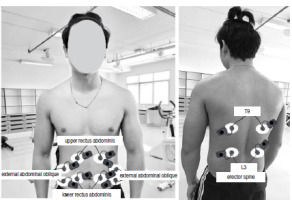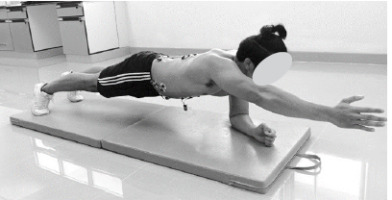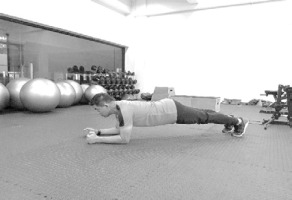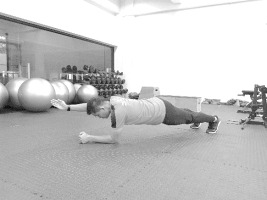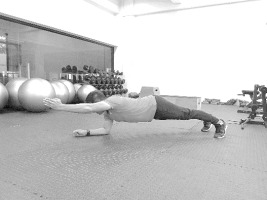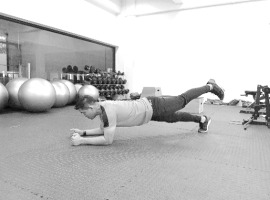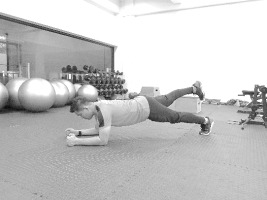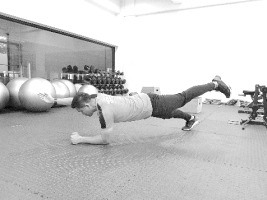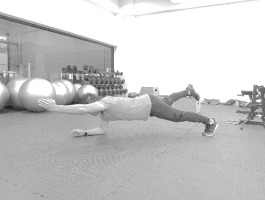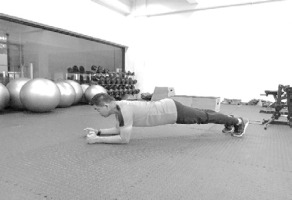Introduction
The core muscles of the human body consist of several muscle groups, such as the m. rectus abdominis (the front side), the m. internal and m. external obliques (the lateral side), the m. erector spinae, m. lumbar multi-fidus, and m. quadratus lumborum (on the back), the m. diaphragm, and the m. iliac psoas [1, 2]. They are considered important parts of the overall spinal function during the movement of the upper and lower extremities to provide stability for everyday movement and are a major factor that allows athletes to move their bodies using various forms of muscle contractions quickly and efficiently [3, 4]. Core stability results from the control of movement and efficiency of the muscles in the lumbopelvic-hip complex developed through a systematic training pattern, allowing the core muscles to function efficiently in response to a variety of movement activities [4-6]. Properly developed core muscles result in reduced resistance to fatigue and injury during the performance of various activities [7]. They also allow athletes to perform more effective skills in terms of muscle strength and core stability, which is the result of integrated muscle work resulting from training the muscles at appropriate levels, leading to the transmission of force from the trunk and pelvis to the limbs, stimulating muscle function, neurological control, cognition, and muscle power [8, 5, 9].
Core muscle strength properly training is very important as the results of the training can help to control the body and improve the efficiency of movement during complex skill movements, especially in various swimming strokes such as freestyle, backstroke, and butterfly [10]. Previous studies have demonstrated the effectiveness of specific core muscle training for swimmers, where 6-8 weeks of core muscle high-intensity interval training (HIIT) combined with a regular training program improved muscle properties, contraction time, extensibility, and elasticity, leading to significantly greater improvements in swimming performance and speed compared to an untrained group [11-14]. Meanwhile, a study on training to develop muscle strength in swimmers using a pattern of HIIT combined with traditional dry-land swimming was reported to be able to develop maximum muscle strength in swimmers, which is due to improved neuromuscular adaptations leading to faster and more efficient perception of responses. From the HIIT pattern [15], it was also found that the HIIT pattern in the unstable and stable surface groups increased maximal muscle strength and balance more than the traditional training control group [16]. Additionally, HIIT has been shown to improve muscle strength and balance in athletes [15, 16].
HIIT is a type of physical activity characterised by interval training, in which high intensity is alternated with short periods of moderate and easy intensity training or alternated with rest periods [16-18]. Therefore, the above evidence demonstrates the effectiveness of HIIT and core training in improving core strength and stability, which are key components in enhancing swimming performance in swimmers. Accordingly, this study aimed to compare the effectiveness of HIIT on core muscle strength in male swimmers. The study hypothesised that after 6 weeks, the experimental group receiving core muscle HIIT would have increased core stability and power than the control group.
Material and methods
Study design
This randomised controlled study involved 20 swimmers who were randomly assigned to an experimental group (n = 10), who underwent HIIT, and a control group (n = 10), who underwent their usual training program. They were randomly assigned to 2 groups by testing and sequencing the swimming speed in a 50-metre swim. The participants were blinded to the intervention before assignment and were unaware of the previous outcomes. Blinding was used to prevent bias in this study. All participants were screened using the physical activity readiness questionnaire (PAR-Q) and were free of any injuries, including musculoskeletal problems that might affect training participation. Before, 4 weeks after, and 6 weeks after initiation of training, subjects were tested for core stability and power. This study was conducted at the Health Science Center, Roi Et Rajabhat University, Roi Et Province, Thailand, with data collection from June 14, 2024, to August 1, 2024.
Participants
The participants in this study were male swimmers. A pre-test power analysis (G power V 3.1.9.2) was performed in this study, indicating that a sample size of at least 8 participants in each group would be required based on a literature review by Karpinski et al. [11], to detect a large effect size (d = 1.86), with a power of 0.8 [19]. The total sample size was 16 participants, and an additional 20% were added to account for any dropouts, resulting in a total of 20 participants and setting the level of statistical significance at 0.05. They were randomly divided into two groups, an experimental group (EG, n = 10; age: 21.40 ± 0.84 years; height: 1.71 ± 0.05 m; body mass: 76.67 ± 15.47 kg) who performed HIIT 3 days per week for 6 weeks, and a control group (EG, n = 10; age: 20.40 ± 0.70 years; height: 1.74 ± 0.05 m; body mass: 73.00 ± 18.49 kg) who performed a routine swimming program. All swimmers used in this study were 19-22 years old, had at least 1 year of competitive experience, had no history of musculoskeletal injuries before participation, and had never received a HIIT regimen (Figure 1). However, if a participant sustained a musculoskeletal injury while participating in this training regimen, they were excluded from participation. All participants were explained the study procedures and objectives, and written informed consent to participate in this project was recorded.
Protocol
Participants were randomly assigned to the experimental or control groups. Swimmers in both groups performed the same routine training program, while swimmers in the experimental group received core muscle HIIT 3 days per week for 6 weeks, totalling 18 sessions. The routine training program for both groups occurred between 6-8 a.m. Training in the experimental group occurred after the swimming training program. During the study, the same procedure was performed at the same time of day and was con ducted in the same order. The assessments were performed at the Health Science Center, Roi Et Rajabhat University, two days before and after completing the core muscle HIIT. All subjects were tested for core stability [13] using electromyography (EMG) measurements by attaching EMG electrodes to the core muscles [20] and tested for core muscle power using 30-second sit-up and 60-second sit-up tests [21] at baseline and after 4 and 6 weeks. The experimental group was assigned to perform core muscle HIIT for 6 weeks, while the control group was assigned to perform their usual training. Before participating, they were informed in detail about the testing procedure and data collection.
Core muscle high-intensity interval training
The training performed in this study consisted of 6 core exercises (flutter kicks, single leg v-ups, trunk extension, alternating arm Russian twists, plank to push up, and bird dog) performed 3 days a week for 6 weeks. The intervention in the experimental group occurred after the routine swimming program on Mondays, Wednesdays, and Fridays, totalling 18 sessions. HIIT was performed at high speed and was divided into 3 periods. During period 1, weeks 1-2, swimmers performed 6 sets of 15 seconds for each exercise, rested 15 seconds between sets, and rested 30 seconds between exercises. In weeks 3-4, swimmers performed 6 sets of 20 seconds for each exercise, rested 10 seconds between sets, and rested 45 seconds between exercises. In weeks 4-6, swimmers performed 6 sets of 30 seconds for each exercise, rested 15 seconds between sets, and rested 30 seconds between exercises. The research assistant conducted a controlled training exercise in the experimental group by inducing the participants to perform at full speed, all of which were monitored by a heart rate monitor. The entire procedure is presented in Table 2.
Table 1
General characteristics of experimental and control groups
Table 2
Core muscle high-intensity interval training
Testing procedures
Core stability was assessed using a surface EMG device (BTS FREEEMG 300, surface EMG device l-35129, Italy), wireless technology, and commercial software (Windows XP, Microsoft.NET framework 1.1). The EMG data signal was acquired with 8 channels at 4 KHz frequency and 16-bit resolution. The software allowed for advanced EMG signal processing, combining electrical muscle data with motion data over a signal range from 0 to 10 seconds in mV values as the muscle is stimulated. Before testing, skin preparation was performed by cleaning the muscles at the specified locations with alcohol before placing the self-adhesive gel-coated electrodes. The core stability test in this study used the plank test [13] and EMG to test the core muscle function by attaching EMG electrodes [20] at the lower rectus abdomen (1 cm lateral to the umbilicus), upper rectus abdomens (3 cm lateral to the umbilicus and approximately half the distance between lower sternum and umbilicus), the external abdominal oblique (approximately 15 cm from the umbilicus), the erector spine at T9 and L3 (located 3 cm lateral to each spinouts process, Figure 2). The core muscle stability test [21] was performed on a flat surface using the elbow and forearm weight-bearing pads to perform the test sequentially in all 8 stages (Figure 3). The procedure for the core stability test is shown in Table 3.
Table 3
The core muscle stability test
The core power test used a 60-second maximal sit-up test, in which participants performed sit-ups as quickly as possible for 60 [21] and 30 seconds using a timer. The steps were as follows: (1) Participants lay supine on the cushion with their hips bent at 45 degrees and their knees bent at 90 degrees; (2) Both palms were placed on their temples, and the research assistant extended both participants’ feet to initiate movement; When the “start” signal was given, the participants bent up so that both elbows could touch their thighs; The participants lowered their torso until their shoulder blades touched the cushion, and repeated until the test time was up; and (5) The number of repetitions achieved in the 30- and 60-second testing periods was recorded (Figure 4).
Statistical analysis
The data in this study are presented as means ± standard deviations. Normality was tested using the Shapiro-Wilk test. Levene’s test for equality showed no significant differences in group variances. Two-way ANOVA with repeated measures and Bonferroni’s post hoc test were used to examine the main effects and interactions between groups (experimental and control groups) and time factors (before, after 4 weeks, and after 6 weeks). Cohen effect sizes were as follows: < 0.2, trivial; 0.2-0.6, small; 0.6-1.2, moderate; 1.2-2.0, large; and > 2.0, very large. Statistical analysis was performed using SPSS IBM 22. The level of statistical significance was set at p < 0.05.
Results
Core stability
Core muscle stability tests using EMG are shown in Table 4. No differences between groups were found in core stability at the baseline of the intervention, indicating similar initial data in both groups and normality of the data using the Shapiro-Wilk test. The intergroup of the experimental and control groups, a two-way ANOVA with repeated measures, and Bonferroni’s post hoc test showed EMG muscle stability in the m. rectus abdominis area after 4 weeks (left; 0.289 ± 0.25 mV, Cohen’s d = 0.54; small, partial eta squared (t|p2) = 0.207, p < 0.05) and 6 weeks (left; 0.365 ± 0.23 mV, Cohen’s d = 1.00; moderate, ηρ2 = 0.221, right; 0.418 ± 0.26 mV, Cohen’s d = 0.96; moderate, p < 0.05), m. obliquus externus area after 4 weeks (left; 0.527 ± 0.08 mV, Cohen’s d = 0.65; moderate, T]p2 = 0.081, p < 0.05) and m. erector spine L3 after 6 weeks (right; 0.162 ± 0.13 mV, Cohen’s d = 0.85; moderate, 1 p2 = 0.169, p < 0.05), which were significantly different from the control group. There was a group x time interaction, the m. obliquus externus area in the experimental group was significantly increased after 6 weeks (left; 0.731 ± 0.35 mV, Cohen’s d = 0.16; trivial, r|p2 = 0.01, p < 0.05) from baseline (left; 0.323 ± 0.44 mV), and the m. erector spine L3 area was significantly decreased after 4 weeks (left; 0.138 ± 0.09 mV, Cohen’s d = 1.03; moderate, r|p2 = 0.004, p < 0.05) and 6 weeks (left; 0.150 ± 0.11 mV, Cohen’s d = 0.27; small, p < 0.05) from baseline (left; 0.298 ± 0.20 mV). In the control group, the m. rectus abdominis (left, right), m. obliquus externus (left, right), erector spine T9 (right), and m. erector spine L3 (right) areas before and after 4 and 6 weeks were not significantly different. The m. erector spine T9 area was significantly decreased after 4 weeks (left; 0.151 ± 0.06 mV, Cohen’s d = 0.92; moderate, p2 = 0.001, p < 0.05) and 6 weeks (left; 0.156 ± 0.07 mV, Cohen’s d = 0.86; moderate, t^2 = 0.019, p < 0.05) and decreased significantly from baseline (0.293 ± 0.21 mV). The m. erector spine L3 area was found to be significantly decreased after 6 weeks (left; 0.124 ± 0.08 mV, Cohen’s d = 0.93; moderate, T]p2 = 0.021, p < 0.05) from baseline (left; 0.297 ± 0.25 mV).
Table 4
The EMG activity in the core stability plank test of the experimental and control groups
Core muscle power
The core power ability using the sit-up test is shown in Table 5. No differences were found between the experimental and control groups using two-way repeated measures t-tests showing core strength values in the 30-second sit-up and 60-second sit-up tests. But in the experimental group, a significant increase after 4 weeks (30-second sit-up; 25.10 ± 4.70 reps, Cohen’s d = 0.76; moderate, Tip2 = 0.137, 60-second sit-up; 47.30 ± 11.08 reps, Cohen’s d = 0.70; moderate, T]p2 = 0.280, p < 0.05) and 6 weeks (30-second sit-up; 31.80 ± 6.18 reps, cohen’s d = 0.54; small, r|p2 = 0.485, p < 0.05, 60-second sit-up; 60.20 ± 10.35 reps, Cohen’s d = 0.39; small, Tip2 = 0.641, p < 0.05) from baseline (30-second sit-up; 21.40 ± 5.06 reps; 60-second sit-up; 40.30 ± 8.87 reps) was observed. After 6 weeks (30-second sit-up; ± 6.18 reps, Cohen’s d = 1.22; large, T(p2 = 0.292, 60-second sit-up; 60.20 ± 10.35 reps, Cohen’s d = 1.20; large, T(p2 = 0.412, p < 0.05) a significant increase from 4 weeks (30-second sit-up; 25.10 ± 4.70 reps, 60-second sit-up; 47.30 ± 11.08 reps, p < 0.05) was observed. In the control group, the core power values in the 30-second sit-up and 60-second sit-up tests were found to be significantly increased after 4 weeks (30-second sit-up; ± 3.26 reps, Cohen’s d = 1.39; large, r|p2 = 0.350, 60-second sit-up 45.10 ± 7.58 reps, Cohen’s d = 1.18; moderate, Tip2 = 0.280, p < 0.05) and 6 weeks (30-second sit-up; 28.90 ± 4.31 reps, Cohen’s d = 2.54; very large, T(p2 = 0.642, 60-second sit-up 56.70 ± 7.01 reps, Cohen’s d =2.53; very large, Tip2 = 0.641, p < 0.05) from before (30-second sit-up; 19.40±3.06 reps, 60-second sit-up 34.40 ± 10.28 reps) and after 6 weeks (30-second sit-up; 28.90 ± 4.31 reps, Cohen’s d = 1.33; large, Tip2 = 0.331, 60-second sit-up; 56.70 ± 7.01 reps, Cohen’s d = 1.59; large, Tp = 0.412, p < 0.05) from 4 weeks (30-second sit-up; 23.80 ± 3.26 reps, 60-second sit-up; 45.10 ± 7.58 reps), respectively.
Table 5
Core muscle power sit-up test of the experimental and control groups
Discussion
This study aimed to compare the effects of 6 weeks of core muscle HIIT on core stability and power in male swimmers. The results of this study were in line with the study hypothesis that core muscle HIIT could significantly improve core stability and core power in swimmers compared to before. The study showed significant improvements in core stability. In the experimental group, there were statistically significant differences (p < 0.05) in the m. obliquus externus (left), and m. erector spine L3 (left), and m. erector spine T9 (left). Part of the reason for the lack of significant improvements in some core muscles may be due to the fact that the participants in this study were only experi enced collegiate swimmers, which may have affected the quality of core training received by all participants due to the different participant levels [22].
In line with previous studies, when trained athletes flexed and moved both shoulder muscles, there were significant improvements (p < 0.05) in the m. rectus abdominis and m. external oblique (left, right) core muscles in both groups [23-26]. Since most conventional swimming training programs are performed face-down, requiring swimmers to maintain a horizontal posture using primarily lumbar extensors, this may have contributed to the partial success of our intervention [24]. However, it can be seen that from the core stability test on the plank test [13] with EMG, it was found that there was a statistically significant improvement in m. rectus abdominis (left, right), m. obliquus externus (left, right), and m. erector spine L3 (right) in the experimental group (p < 0.05) when compared to the control group. From the data of the core muscle power test in both the experimental and control groups, which was tested by the 30- and 60-second sit-up tests [21], it was found that before, after 4 weeks, and after 6 weeks there were statistically significant differences (p < 0.05). But no difference was found between the groups, which is in line with previous studies indicating that the form of core muscle training and swimming skill training have the characteristics of bending the body forward and stretching the body backwards as well, causing many tasks related to the oblique muscles and opposite to the abdominal muscles and back muscles, which these muscle groups are involved in rotational movements, such as throwing, kicking, lifting, swinging arms and legs up and down in various planes [25, 26], which may allow both groups to develop stability and core muscle power as well. However, considering the incremental improvements in both groups, it can be seen that the muscle power test in the sit-up position in the 30-second max and 60-second max after 6 weeks in the experimental group had an average of 26.10 times and 49.27 times, respectively. It can be said that the group that received HIIT of the core muscles for an additional period of time in addition to the normal training program had faster neural activation, resulting in more efficient motor unit coordination, perception, and response, which allowed them to improve core muscle power more than the control group that trained according to the normal program.
Consistent with previous studies, it was found that strengthening the core muscles at an appropriate intensity for 6 weeks can improve the stability of the lumbar spine, resulting in biomechanical changes that allow swimmers to have good muscle power. Muscle power can be an indicator of swimmers’ performance in moving faster and more durable in the water [13, 27, 28]. This ability is due to the musculoskeletal system’s joint efforts to allow the body’s arms, legs, upper extremities, and lower extremities to move efficiently. Therefore, improving the core muscles to address proper stability and muscle power will allow athletes to control their body position. The parts related to body positioning are the head, shoulders, torso, and legs. When these muscles can be arranged in a near-straight line, it will help reduce the resistance of the water mass to the body well throughout the swimming movement [29-31].
Limitations of the study
The limitation of this study is that the participants were only university-level amateur swimmers aged 19-22 years who trained in the national university sports competition. The training program may not be as intensive as the national level. Therefore, the results are only for this population group. This study only measured core muscle performance using EMG in the plank position. Future studies should consider using EMG in muscle power testing for athletes to identify changes in muscle function more completely and conduct the experiment in female swimmers.
Conclusions
Six weeks of core muscle HIIT significantly improved core stability in the experimental group compared to the control group that did not receive HIIT as an addition to their conventional program, and the trained group also improved core muscle power more than the control group. These results can be used as information to help coaches and athletes optimise the function of the muscles that support swimming performance.


